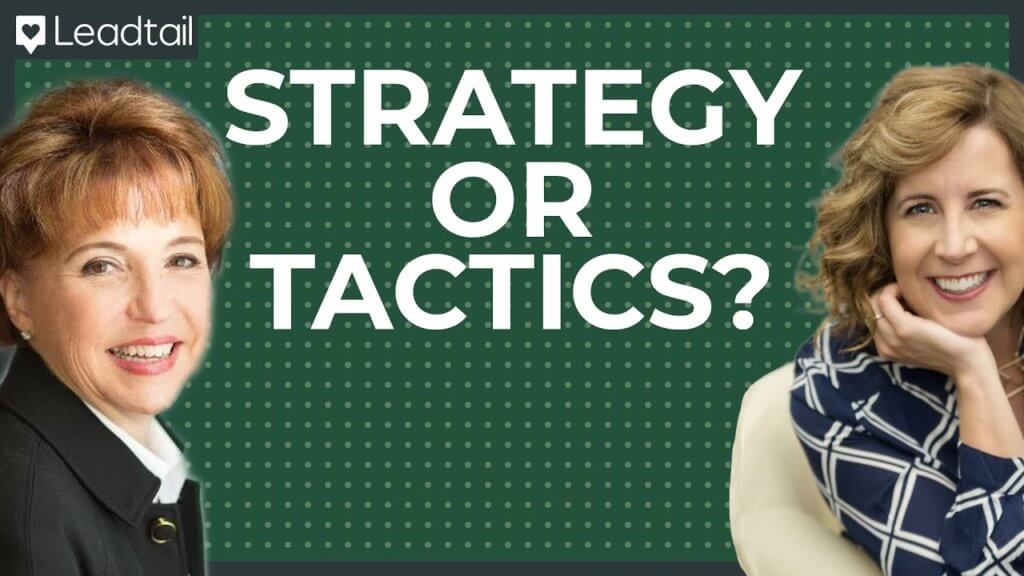In this episode of Leadtail TV’s “CounterPoint B2B,” Christine Crandell and Jennifer Davis solve a marketing mystery.
“Can we have a plan? I’m not trying to sound sarcastic, but can we at least have a plan?” That’s Christine Crandell, president of consulting firm New Business Strategies, talking to CounterPoint B2B host Steve Mann about the saddest marketing tragedy of all time:
The death of the marketing strategy.
Brands used to strategize, and it was incredible. They had a game plan, an action plan, a master plan, or at least some kind of plan. Think of the campaign rollouts of the ’80s and ’90s that lasted months, and sometimes years. Marketers squished their values, goals, and objectives into a single comprehensive blueprint that influenced everything that came afterward: Messaging, methodology, merchandise, monitoring.
It worked like a charm.
Flash forward to now, and there’s no forethought. No foresight. No nothing. Brands rely on marketing tactics, but there’s no strategy. It’s as if marketers live by Nike’s famous motto: Just Do It. (And think of the consequences later.)
All this has Christine scratching her head:
“Do we know what we’re gonna do in three months? Six months? So you’re going to do a campaign. OK. What’s the deadline? Who’s going to work on it?”
Benjamin Franklin said: “If you fail to plan, you’re planning to fail.” But perhaps Christine says it better: “Have a plan. Have metrics.”
It’s not rocket science. If you don’t have a solid plan in place with metrics and a clear delegation of duties, your marketing tactics will die a slow death.
So plan to have a plan.
The Fall of the Marketing Strategy?
Christine, a self-described “customer service prima donna,” thinks brands chose tactics over strategy sometime around 2000.
Short-term economics suddenly replaced long-term strategic vision. CEOs cared more about quarterly earnings reports and venture capital benchmarks than meaningful campaign rollouts.
There was a focus on money over marketing. No momentum. No longevity.
“The exit strategy wasn’t to build a large organization that’s healthy or contributed to society, but to sell a feature to Google for 7x.”
Perhaps the dot-com boom reflected the tilt toward tactics. Or the start of the startup. Whatever the reason, a new marketing model emerged built on profit, not policy. And that marketing model was very much green.
Jennifer Davis, head of product marketing for AWS Training and Certification, agrees:
“There was an adage of ‘Follow the money.’ In a world where companies were going public and had to position themselves as long-term investments, the conversation changed.”
Jennifer thinks there’s another suspect: A focus on innovation rather than stability.
“The idea that organizations need to learn faster, satisfying the needs of the customer faster, and innovate faster leads to a different management style, different internal communications, and different priorities.”
Is it this that killed the marketing strategy?
“This trend means a lot of B2B leaders across the C-suite don’t actually understand marketing. They don’t have an appetite for strategic marketing.”
There are other theories. In the report “Developing Future Strategy: Long-Term Thinking for Marketers,” Econsultancy hypothesizes why marketers don’t think long term anymore:
- They’re too busy.
- They don’t know the business exists.
- They don’t have data.
- They don’t think creatively.
- They don’t communicate their thinking.
- They lack the correct processes.
There doesn’t seem to be one culprit. The death of the marketing strategy continues to be a whodunnit — or a whatdunnit.
Will the Marketing Strategy Rise from the Ashes?
Once B2B brands rediscover the value of strategic planning, they can align their values, goals, and objectives again.
Jennifer recommends:
- To have, at the very least, a short-term plan. This quick-fix won’t replace long-term strategizing, but it’s a start. “You need step one before you get to step two.”
- To look at your calendar. Set aside time for implementing your plan. Reschedule the unimportant stuff.
Then make everything you do more strategic.
“One, two, 10% more strategic than it was before. Often people look at a project or campaign and have such a biased reaction they forget to think big about it or give it more resources or momentum.”
So take a time machine back to 2000, when strategies focused on the long game rather than short-term economic success, and reinvent your current campaigns.
“If you want to be the agent of change in your organization, start with the projects already on your plate,” adds Jennifer. “Then do them differently.”
For more insights into marketing strategy versus tactics, watch Christine and Jennifer’s CounterPoint B2B episode here.
Want to have a conversation about social media? Let’s talk.
